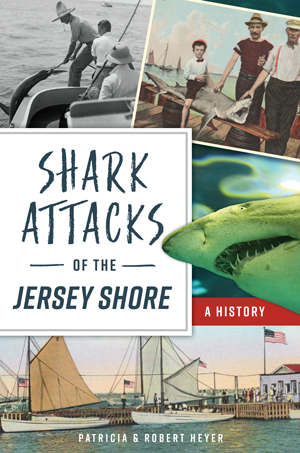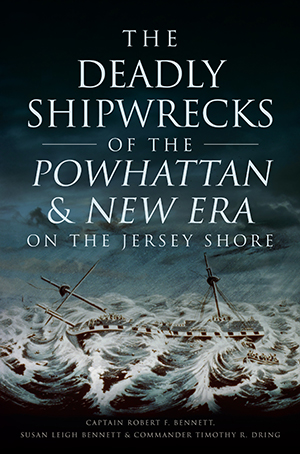
Are sharks the most feared animal on the planet? Definitely. How can this be? They aren’t found on land, wandering the streets, lurking in city shadows, or even hiding under your bed. And even though we all know the odds of a shark attack are minuscule, approximately eight people die by shark every year. So how does this seafaring predator get such a fearsome rap? And how, in 1916, did the tiny, blue collar inland town of Matawan, NJ receive a most unwanted monster?
The Summer of Horror
Just as East Coast cities were blossoming into modern metropolises, beach resorts boomed. New Jersey’s famed Jersey Shore provided a needed escape from the noisy, smelly, overcrowded city streets of New York, Brooklyn, and Philadelphia. The famed Atlantic City became a popular vacation destination for the entire East Coast. But the Garden State was a stricken with an unforeseen natural tragedy. Shockingly, in 1916, four shark attacks occurred on the same day! While July 12 started off as a typical summer day, Matawan, New Jersey, located thirty miles north of Spring Lake and situated on a bluff fifty feet above the creek and eleven miles inland, would be the site of four shark attacks, all occurring within the span of about an hour and a half, and where no one had ever dared to think it could.
WARNING!
Thomas Cottrell, a retired captain, witnessed an enormous dark form moving with the tide toward the old Matawan docks. He knew that sharks don’t swim in brackish water like Matawan Creek, but he remembered recent accounts of shark attacks in nearby Spring Lake. No one had ever heard of a shark swimming eleven miles inland. Cottrell shouted warnings, but Lester Stillwell and his buddies didn’t hear him…

Lester Stillwell
Eleven-year-old Lester went to work with his father on July 12, like most days. Even though he suffered from epilepsy, Lester ran off to go swimming with his buddies after lunch. When Lester’s friend Ally O’Hara felt something rough brush against his leg, he didn’t panic — what was there in Matawan Creek to fear? Suddenly, a large dorsal fin poked out of the water. The boys screamed, and Lester vanished. The boys ran back into town, and three men sprinted to the edge of the creek, searching the surface for Lester. No one believed it was actually a shark. The would-be rescuers assumed that the boy must have drowned. Two days later, Lester’s Stillwell’s body was recovered when it floated to the surface about 150 yards downstream.
Arthur Smith
When carpenter Arthur Smith rushed to the site, he plunged into the creek looking for the lost child. Immediately, Smith was whacked by something unseen. Blood oozed from his leg as he swam for shore. The shark now had a second victim that day. Smith survived his encounter with with over a dozen stitches.
Related: Rescuing the SS Pendleton: The Coast Guard’s Greatest Rescue
Stanley Fisher
Local shopkeeper Stanley Fisher joined the underwater search for poor Lester Stillwell. Even though Stanley watched as Arthur Smith was pulled onto the creek bank, he kept diving. When Stanley spotted the boy’s body along the bottom, he grabbed a leg and tried to surface. Before he could free the victim’s limb, the shark found Stanley’s thigh. Others in the search party rushed to Stanley, and beat the shark from their boat. Stanley suffered a wide laceration on his right thigh that ran from his hip to his knee. At least ten pounds of flesh were removed, leaving the remainder of his leg a bloody mass. The physician on site feared Stanley wouldn’t survive the trip to the nearest hospital, twenty miles away. Hours later, he was put on the train, which sped nonstop to Long Branch, but he died in the operating room crying, “I did my duty.”
Joseph Dunn
Fourteen-year-old Joseph Dunn, along with his brother Michael, took off from New York City by train for a one-day trip to New Jersey. They found a perfect spot for a dip in Matawan Creek. Michael was lucky, Joseph wasn’t. Something grabbed his leg, yanking him back into the creek. Michael dove into the water, trying to pull Joseph to safety. Thomas Cottrell arrived on the scene, and was able to load Joseph in his boat. Back on shore, the rescue party took the day’s fourth victim by car to New Brunswick, where Joseph would spend the next fifty-nine days recuperating in the hospital.
The community was a shocked into action and sought to find the apex predator that had invaded their unsuspecting town. A mob swarmed the creek with shotguns, harpoons, rakes, spears, clubs, axes, and dynamite. Captain Cottrell, one of the day’s heroes, declared he had caught the 230-pound, seven-foot bull shark at the mouth of Matawan Creek. He later sold tickets to view the Matawan Creek “man-eater.” Impossible as it seemed, a shark attack happened inland, far from the the salty coastline, a shark’s natural hunting ground.

Eager to learn more? Check out the book Shark Attacks of the Jersey Shore: A History as well as its similar titles at arcadiapublishing.com!




